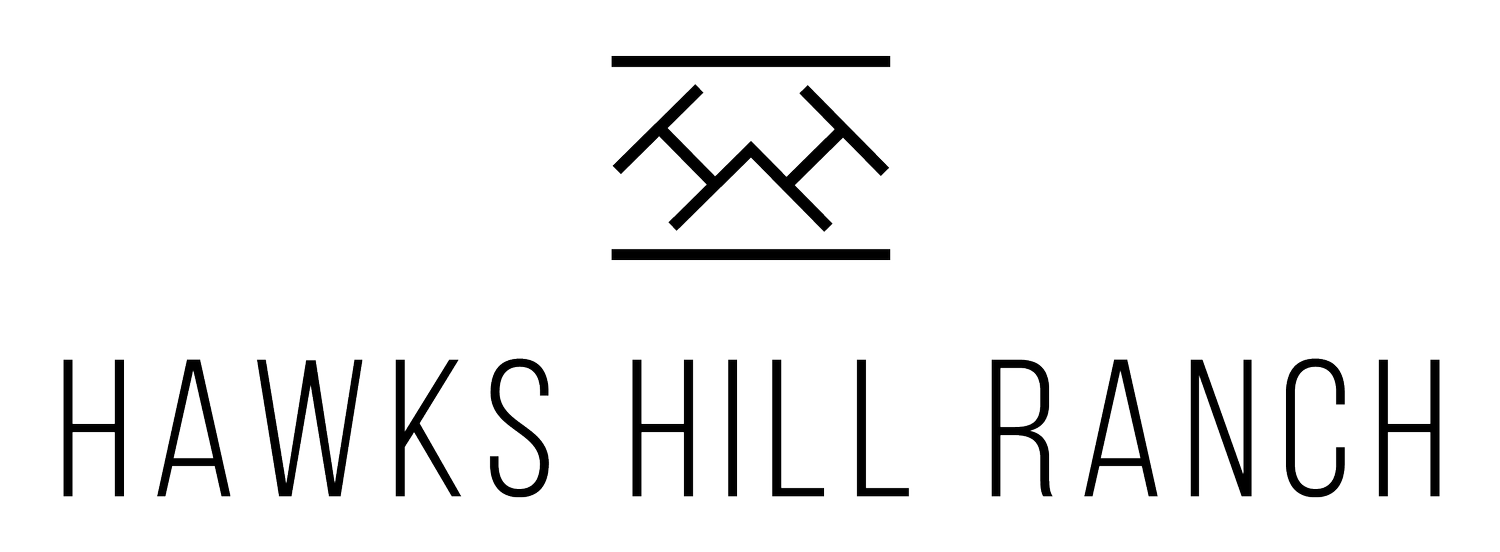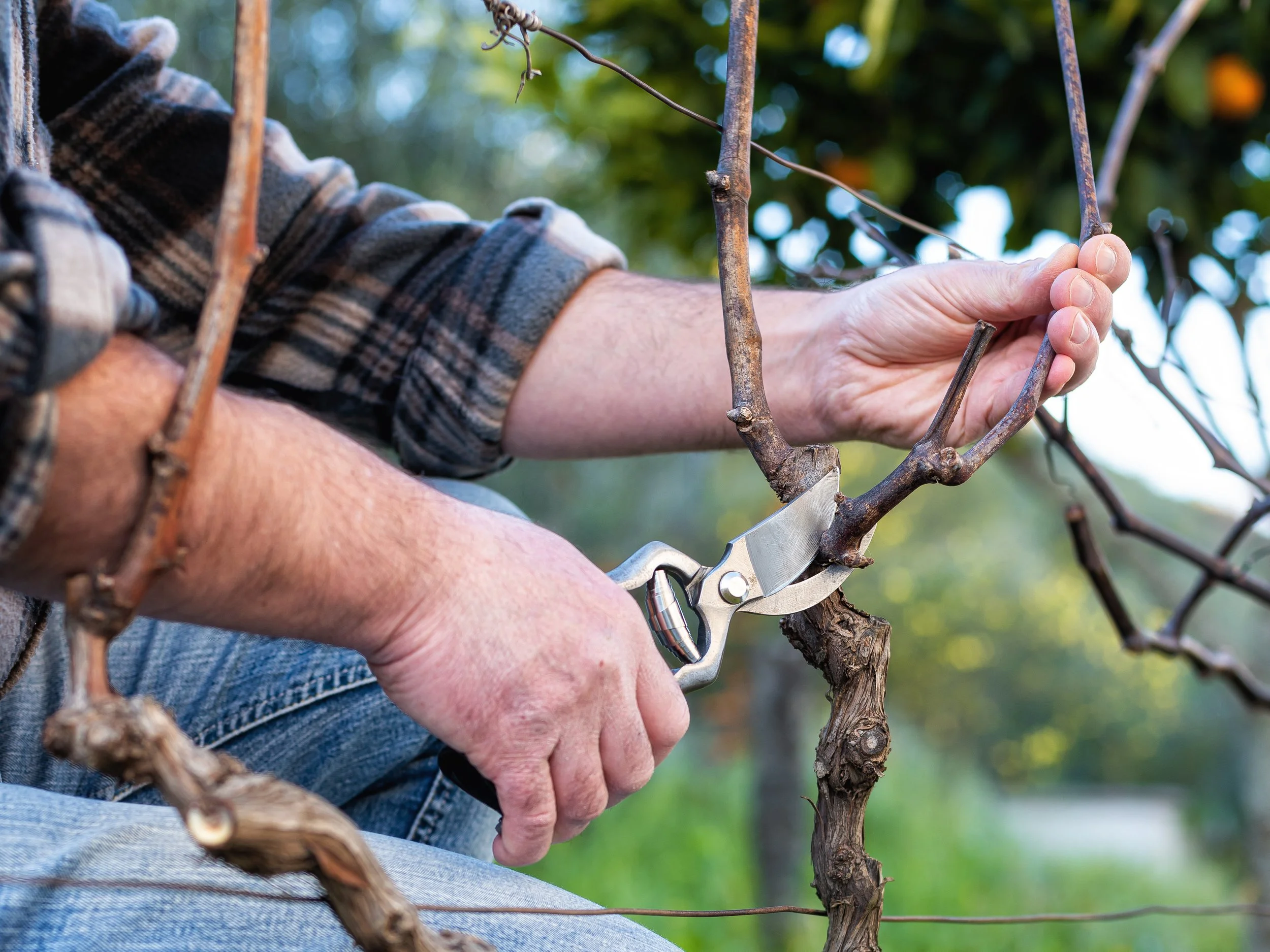Cultivating the Perfect Vintage at Hawks Hill Ranch Vineyards
Paso Robles, California - Wine Country Region Pruning Season
The cool, crisp air of Winter Season in Paso Robles signals more than just the start of a new year; it marks one of the most crucial times for Hawks Hill Ranch’s vineyard—pruning season. Pruning may not be as glamorous as the grape harvest or as celebrated as the bottling of wine, but it is a cornerstone of our vineyard's success. Without this intricate and labor-intensive process, the vibrant wines we’re known for wouldn’t carry the same depth, balance, or character.
This year, our team has rolled up their sleeves and begun shaping the future of our vines. While it may look like an act of cutting back, pruning is an investment in growth. By carefully selecting which canes stay and which go, we ensure that each vine can thrive in the unique terroir of Paso Robles. It’s a delicate dance between science, tradition, and intuition—one that sets the stage for a remarkable vintage.
Why Pruning Matters: The Art and Science Behind the Shears
Pruning is more than just a winter chore; it’s the lifeblood of vineyard management. At Hawks Hill Ranch, every snip of the shears is a deliberate decision that influences the health of the vines, the quality of the fruit, and ultimately, the character of our wine.
By removing excess canes and leaving the optimal number of buds, we regulate how much fruit each vine produces. This balance ensures that the grapes ripen evenly and develop the concentrated flavors that define our wines. Pruning also improves air circulation and sunlight exposure, reducing the risk of disease and creating ideal conditions for the upcoming growing season.
In Paso Robles, with its warm days, cool nights, and diverse microclimates, timing and technique are everything. Late pruning can delay bud break, offering protection against frost, while early pruning might be necessary for dry-farmed blocks that need a head start before the soil dries out. Every decision we make is tailored to the needs of our vineyard and the nuances of our region.
Timing Is Everything: When to Prune and Why It Matters
At Hawks Hill Ranch, the timing of pruning is as carefully considered as the pruning itself. Winter pruning begins after the vines have gone dormant, usually in late December or early January, and can extend into February. This window allows us to assess the vines’ growth from the previous season and plan for the next.
Pruning too early risks exposing fresh cuts to winter rains, which can carry fungal spores that lead to wood diseases like Eutypa or Esca. By starting in January, after the heaviest rains have passed, we reduce this risk and ensure the longevity of our vines. Additionally, the later we prune, the more we can delay bud break, a critical strategy in frost-prone areas. Paso Robles’ varied topography means that some blocks are more susceptible to frost than others, so we prioritize these areas for later pruning.
However, not everything can be done at the last minute. Dry-farmed vines, which rely entirely on natural rainfall, benefit from earlier pruning to make the most of available soil moisture. By balancing these factors, we optimize the health and productivity of our vineyard.
Vine Balance: The Key to Exceptional Grapes
Pruning isn’t just about cutting; it’s about balance. Each vine at Hawks Hill Ranch tells a story of its growth over the past year, and it’s our job to read that story and guide its future. Vigorous vines with strong growth need more buds left to spread their energy, while weaker vines require fewer buds to concentrate their growth. This balance is critical to producing grapes that are ripe, flavorful, and true to our terroir.
Balanced vines lead to balanced wines. Too much growth can result in green, unripe flavors, while too little can create harsh, overly concentrated wines. By leaving the right number of buds and canes, we ensure that each vine grows just enough to produce exceptional fruit without being overburdened. This principle of balance has been passed down through centuries of viticultural tradition and remains the foundation of our approach.
The Techniques Behind the Craft: Spur vs. Cane Pruning
Different sections of the Hawks Hill Ranch vineyard require different pruning techniques, tailored to the grape varieties, vine age, and specific growing conditions. Two primary methods dominate our approach: spur pruning and cane pruning.
Spur Pruning: This method involves leaving short spurs with two buds along the cordon. It’s ideal for varieties like Cabernet Sauvignon and Syrah, which thrive with consistent spacing and even canopy growth. Spur pruning simplifies vineyard management and promotes uniform fruit development.
Cane Pruning: This technique involves leaving one or two long canes with multiple buds, along with a spur for next year’s growth. It’s used for varieties like Pinot Noir, where precise bud selection is crucial for balancing the vine’s vigor. Cane pruning requires more skill and attention but offers greater flexibility in achieving vine balance.
Each method has its advantages, and our team carefully evaluates each vine to determine the best approach. By combining these techniques, we create a vineyard that’s as diverse and dynamic as the wines it produces.
Preparing for the Future: Pruning’s Role in Sustainability
At Hawks Hill Ranch, pruning is more than just vineyard maintenance; it’s an investment in sustainability. By managing the vines’ growth and ensuring their long-term health, we’re preserving the land for future generations. Pruning also plays a vital role in our organic and biodynamic practices, promoting natural balance and reducing the need for chemical interventions.
Healthy, well-pruned vines are more resilient to pests, diseases, and environmental stresses. They also produce better fruit, with concentrated flavors and balanced acidity. This commitment to sustainability is at the heart of everything we do, from the vineyard to the winery.
A Labor of Love: The Human Touch Behind Every Cut
Pruning at Hawks Hill Ranch is a hands-on process, carried out by a dedicated team of skilled vineyard workers. It’s an art as much as a science, requiring experience, intuition, and a deep understanding of the vines. Each cut is a decision that balances the needs of the plant with the goals of the vineyard, and every vine is treated with care and respect.
This human touch is what sets our vineyard apart. While technology has its place in modern viticulture, there’s no substitute for the trained eye and steady hand of a skilled pruner. By investing in our team and valuing their expertise, we’re ensuring the quality of our wines and the future of our vineyard.
Paso Robles Terroir: How Pruning Enhances Our Unique Region
Paso Robles is a region of contrasts, with warm, sunlit days and cool, breezy nights. This diurnal temperature swing is ideal for grape growing, allowing the fruit to develop complex flavors while retaining natural acidity. Pruning plays a crucial role in harnessing these conditions, shaping the vines to maximize sunlight exposure and airflow.
Hawks Hill Ranch vineyard’s diverse microclimates require a tailored approach to pruning. Hillside blocks may need different timing and techniques than lower-lying areas, and each variety responds differently to the region’s unique terroir. By understanding and adapting to these factors, we’re able to produce wines that truly express the essence of Paso Robles.
Book a Ranch Tour: See Hawks Hill Ranch Vineyards in Action
Pruning season is a reminder of the dedication and care that go into every bottle of Hawks Hill Ranch wine. Why not see it for yourself? Book a ranch tour and discover the unique process behind how we take care of our vineyards. From the artistry of pruning to the stunning landscapes of Paso Robles, you’ll gain a deeper appreciation for the craftsmanship that defines Hawks Hill Ranch. Book your tour today and experience the enchanting terroir firsthand, immersing yourself in the beauty of the surroundings and the artistry of Hawks Hill Ranch wines.



